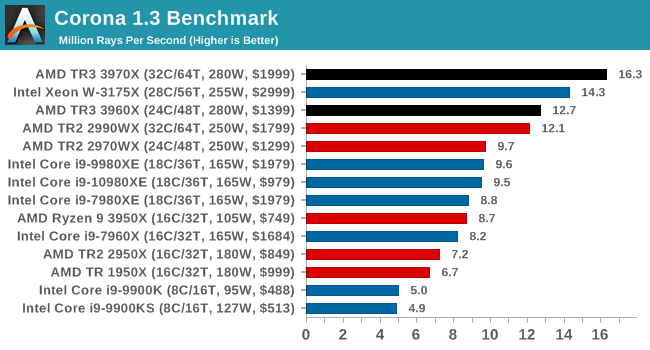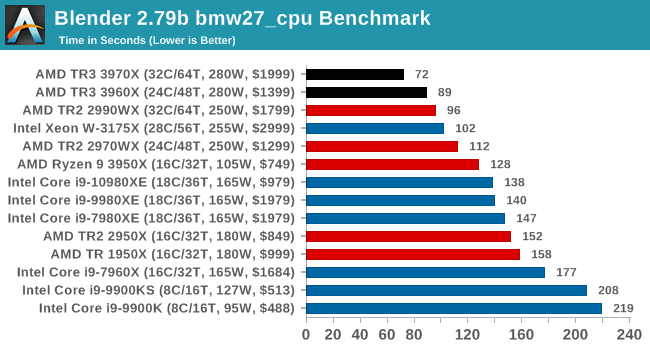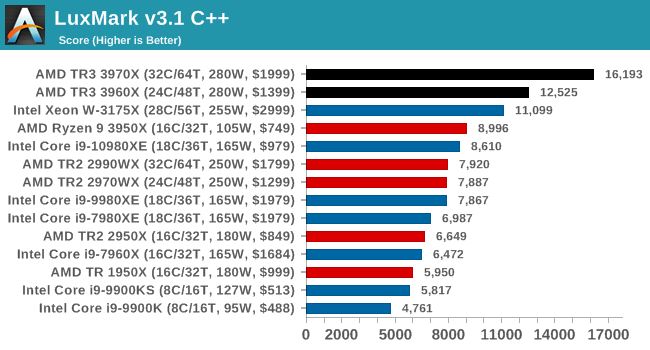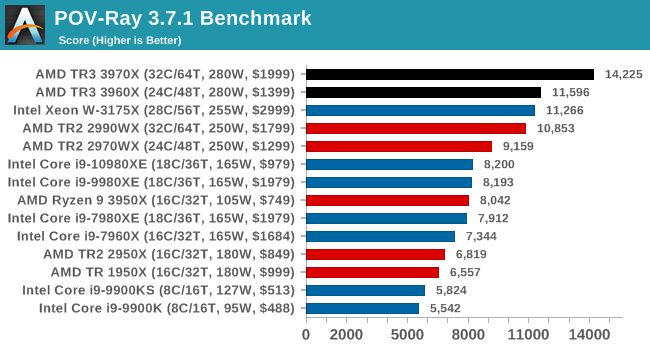The AMD Ryzen Threadripper 3960X and 3970X Review: 24 and 32 Cores on 7nm
by Dr. Ian Cutress, Andrei Frumusanu & Gavin Bonshor on November 25, 2019 9:05 AM ESTCPU Performance: Rendering Tests
Rendering is often a key target for processor workloads, lending itself to a professional environment. It comes in different formats as well, from 3D rendering through rasterization, such as games, or by ray tracing, and invokes the ability of the software to manage meshes, textures, collisions, aliasing, physics (in animations), and discarding unnecessary work. Most renderers offer CPU code paths, while a few use GPUs and select environments use FPGAs or dedicated ASICs. For big studios however, CPUs are still the hardware of choice.
All of our benchmark results can also be found in our benchmark engine, Bench.
Corona 1.3: Performance Render
An advanced performance based renderer for software such as 3ds Max and Cinema 4D, the Corona benchmark renders a generated scene as a standard under its 1.3 software version. Normally the GUI implementation of the benchmark shows the scene being built, and allows the user to upload the result as a ‘time to complete’.
We got in contact with the developer who gave us a command line version of the benchmark that does a direct output of results. Rather than reporting time, we report the average number of rays per second across six runs, as the performance scaling of a result per unit time is typically visually easier to understand.
The Corona benchmark website can be found at https://corona-renderer.com/benchmark

Being fully multithreaded, we see the order here follow core counts. That is except for the 32-core 2990WX sitting behind the 24-core 3960X, which goes to show how much extra performance is in the new TR generation.
Blender 2.79b: 3D Creation Suite
A high profile rendering tool, Blender is open-source allowing for massive amounts of configurability, and is used by a number of high-profile animation studios worldwide. The organization recently released a Blender benchmark package, a couple of weeks after we had narrowed our Blender test for our new suite, however their test can take over an hour. For our results, we run one of the sub-tests in that suite through the command line - a standard ‘bmw27’ scene in CPU only mode, and measure the time to complete the render.
Blender can be downloaded at https://www.blender.org/download/

We have new Threadripper records, with the 3970X almost getting to a minute to compute. Intel's nearest takes almost as long, but does only cost half as much. Again, the 3960X puts the 2990WX in its place.
LuxMark v3.1: LuxRender via Different Code Paths
As stated at the top, there are many different ways to process rendering data: CPU, GPU, Accelerator, and others. On top of that, there are many frameworks and APIs in which to program, depending on how the software will be used. LuxMark, a benchmark developed using the LuxRender engine, offers several different scenes and APIs.
In our test, we run the simple ‘Ball’ scene. This scene starts with a rough render and slowly improves the quality over two minutes, giving a final result in what is essentially an average ‘kilorays per second’.

Our LuxMark test again pushes both TR3 processors out in the lead.
POV-Ray 3.7.1: Ray Tracing
The Persistence of Vision ray tracing engine is another well-known benchmarking tool, which was in a state of relative hibernation until AMD released its Zen processors, to which suddenly both Intel and AMD were submitting code to the main branch of the open source project. For our test, we use the built-in benchmark for all-cores, called from the command line.
POV-Ray can be downloaded from http://www.povray.org/

More rendering, more wins for AMD. More losses for the 2990WX, even though on these tests it still beats the 10980XE quite easily.











245 Comments
View All Comments
Slash3 - Tuesday, November 26, 2019 - link
AnandTech frustratingly doesn't seem to ever list their memory subtimings, but as they test at "JEDEC" standard, it may be as loose as 2933 CL19-19-19 vs your 2933 CL14. This could easily account for the difference in benchmark results.alufan - Monday, November 25, 2019 - link
So Thread ripper is here, I will never have a use for this chip but I want one...just because, probably the single biggest uplift in CPU performance for a great many years.Still 10 intel featuring articles on the main page vs 4 featuring AMD though, shame really and it would have been nice for you to have a proper dig at intel for its pathetic attempt to skew CPU bench results by moving the embargo forward, try taking a tip off linus man he told it like it was as have many others.
Grobert783 - Monday, November 25, 2019 - link
So many cores and yet no one cares PLUS we all know AMD sucks. Thank youyeeeeman - Monday, November 25, 2019 - link
LolXyler94 - Monday, November 25, 2019 - link
Ah yes, the infamous "Nobody cares" argument of a fanboy.And yet you cares enough to click the article, go to the comment section, and write this comment. I won't comment about your other comment though, clearly you didn't RTFA
darwi - Monday, November 25, 2019 - link
With so much cores Anandtech should consider virtualization benchmark/uses casesthere is some good automated Lab Scripts available.
On Windows Nested Virtualization is still not enabled on AMD Processor.
-> still not announced for Windows 20H1, perhaps for 2OH2 since major overhaul for Azure is underway.
Ryzen Master is still incompatible with VBS (Virtualization based Security).
This situation prevent to test some features in Windows VM :
- With more and more feature relying on virtualization (WSL, Security, workload isolation, ...)
- For advanced scenarios (Labs for testing infrastructure deployment, ESXi, hyper-v, compiler, etc...)
By ignoring the 1k segment AMD could overplay their advantages :
- the cpu is only a part of the package (you have to add a beefy psu and cooling system and a decent amount
of RAM) if you want to make a meaningfull use of such platform.
- the moherboad price take a major rise (Apple accessories manufacturer syndrom ?) - without high ends feature regarding connectivity
where are the multi-gig network and Thunderbolt ports ?, but RGB pins are plenty ...
- forcing the early TR adopters to a 2k-2,5k investment to jump to the TR3+ architecture (if cooler and RAM, PSU remain the same)
and chipset reset could do some damage too.
And finally the 10980XE (with more PCI 3 lanes, and more memory) will not be the best but enough and more affordable.
I'm a an owner of TR 1950X.
Questions :
> Nested Virtualization will eventually comming to AMD ? (for a future interview with AMD CEO/CTO)
> Air Cooling is it still suitable for TR3 ?
And thanx to Anandtech for those reviews and the worth of drilling down into details.
That's my 2cents.
Irata - Monday, November 25, 2019 - link
Wait, what ? The 10980XE has more PCIe lanes than TR3?And the rest...is pot legal where you live?
darwi - Monday, November 25, 2019 - link
I was comparing with the nearest AMD offrer to the 10908XE v: The Ryzen 3950X.Furthermore the PCI4 cards are very few for the moment.
May be there is some room for a TR3 3950X like the TR 1920 in his time.
The 1K is for 1K$.
lobz - Tuesday, November 26, 2019 - link
I usually don't do drugs but I'll have some from what you're having...Xyler94 - Monday, November 25, 2019 - link
In what world is 60 PCIe 4.0 lanes less than 48 PCIe 3.0 lanes?You do know... that PCIe 4 is backwards compatible, so Threadripper has effectively 60 lanes of PCIe 3, right? I don't know about you... but 60 is more than 48...